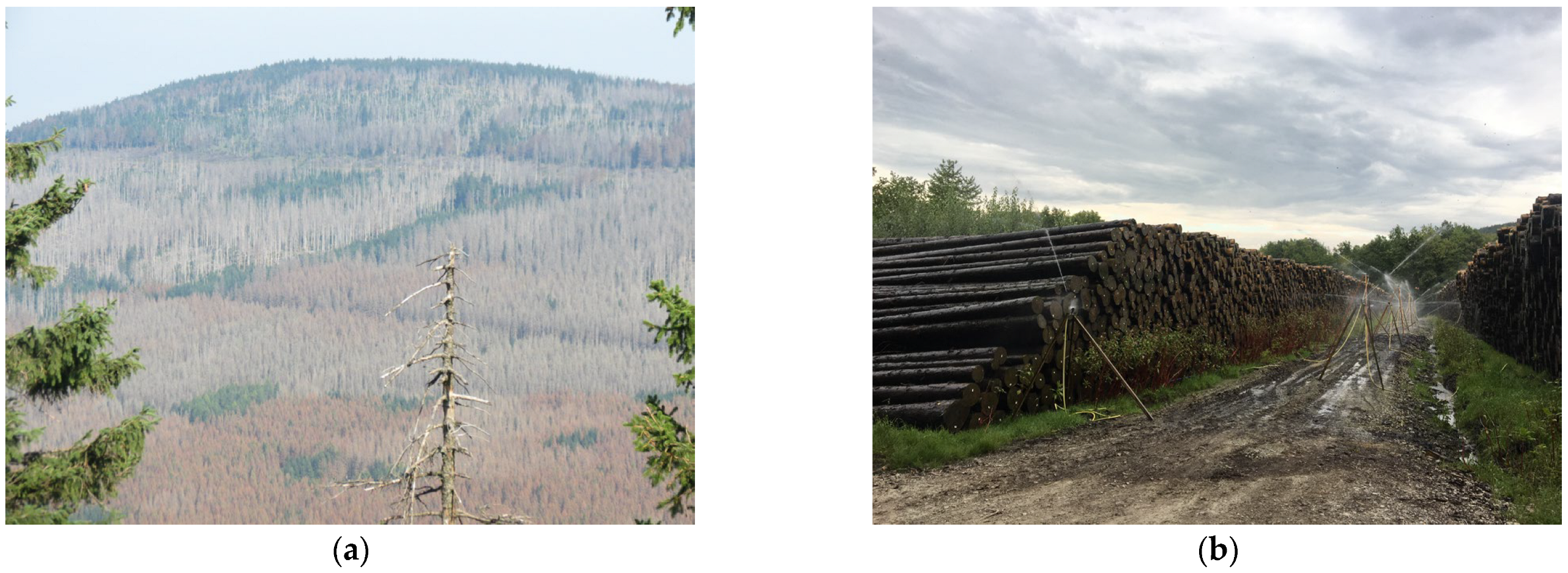Foil Storage of Storm-Felled Timber—Long-Term Monitoring of Norway Spruce Piles in Germany
Abstract
:1. Introduction
2. Materials and Methods
2.1. Monitoring the Interior Atmosphere of Foil Tent Stores
2.2. Assessment of Roundwood Quality
- Core cracks with a diameter of ≤1/2 of the log are permitted.
- Ring peeling with a diameter of ≤1/3 of the log is permitted.
- Superficial discoloration is permitted.
- Insect bore holes in the wood are not permitted.
- Hard rot (rot spots), which is located in the outer mantle of the buttresses up to 15% of the log diameter, is permitted.
- Softening due to rot is not permitted.
- Core cracks are permitted.
- Ring peeling up to a diameter of ≤1/2 of the log is permitted.
- Insect feeding holes in the wood of <2 mm are permitted. Bore holes of ≥2 mm are not permitted.
- Hard rot (rot spots) is permitted, and softening due to rot is only conditionally permitted in the outer mantle of the buttresses.
3. Results and Discussion
3.1. Interior Atmosphere of Foil-Packed Piles
- (1)
- low risk, due to consistently unfavorable conditions for fungal growth and wood degradation,
- (2)
- moderate risk, due to favorable conditions for fungal wood damage occurring in the short term,
- (3)
- high risk, due to favorable conditions for fungal wood damage after less than two years of storage.
3.2. Quality Changes of Stored Roundwood
4. Conclusions
Author Contributions
Funding
Institutional Review Board Statement
Informed Consent Statement
Data Availability Statement
Acknowledgments
Conflicts of Interest
References
- Pöschel, F. 14,6 Mio. fm durch Stürme gefallen. 2018. Available online: https://www.holzkurier.com/rundholz/2018/04/sturmbilanz-deutschland.html (accessed on 12 October 2022).
- Lutze, M. Nach der Kalamität ist vor der Kalamität. LWF Aktuell 2014, 99, 45–49. [Google Scholar]
- Yalcin, M. Problems encountered in log depots and measures to combat them: A review. BioResources 2020, 15, 2082–2095. [Google Scholar]
- Günther, B.; Starke, N.; Meurer, A.; Bues, C.T.; Fischer, S.; Bremer, M.; Freese, M. Impact of Storage Method on the Chemical and Physical Properties of Poplar Wood from Short-Rotation Coppice Stored for a Period of 9 Months. BioEnergy Res. 2021, 14, 469–481. [Google Scholar] [CrossRef]
- Starke, N. Lagerung von Pappelrundholz aus Kurzumtriebsplantagen–Evaluierung Verschiedener Lagerungsverfahren unter Besonderer Berücksichtigung der Holzfeuchte als Möglicher Parameter einer Automatisierten Qualitätsüberwachung. Ph.D. Thesis, Technical University Dresden, Dresden, Germany, 2022. [Google Scholar]
- Bues, C.T.; Weber, A. Eine neue Methode der Rundholzlagerung. Forstwiss. Centralbl. Tharandter Forstl. Jahrb. 1998, 117, 231–236. [Google Scholar] [CrossRef]
- Mahler, G. Konservierung von Holz durch Schutzgas. Allg. Forstz. 1992, 47, 1024–1025. [Google Scholar]
- Metzeler, V.B.; Groß, M.; Mahler, G. Pilzentwicklung in Fichtenholz unter Schutzgasatmosphäre. Eur. J. For. Pathol. 1993, 23, 281–289. [Google Scholar] [CrossRef]
- Schüler, G.; Wurster, M. Rundholzkonservierung unter Sauerstoffabschluss. Wald Holz 2000, 3, 47–49. [Google Scholar]
- Maier, T. Konservierung von Rundholz unter Sauerstoffabschluss–Folienkonservierung. Ph.D. Thesis, Albert-Ludwigs-University, Freiburg, Germany, 2005. [Google Scholar]
- Gerecensér, K.; Molnár, A.; Bejó, L. A fólia alatti rönktárolás lehetőségei: I. rész: Optimális rönktárolási módszer kialakítása [Log storage under plastic wrap Part 1: Creating an optimal log storage method]. Faipar 2007, 55, 3–8. [Google Scholar]
- Rabe, C. Einfluss Verschiedener Gasatmosphären auf das Wachstum Holzzersetzender Pilze. Ph.D. Thesis, Albert-Ludwigs-University, Freiburg, Germany, 2008. [Google Scholar]
- Rademacher, P.; Hapla, F. Investigations of wood conservation in spruce logs after storage under plastic foil. Part II: Physical and elasto-mechanical properties of the produced sawn-timber. Forstarch 2012, 83, 144–154. [Google Scholar]
- Rademacher, P.; Hapla, F.; Leder, B. Investigations of wood conservation in spruce logs after storage under plastic foil. Part I: Time series of climatic and environmental parameters of the stored wood. Forstarch 2011, 82, 3–9. [Google Scholar]
- Solar, A.; Janak, K.; Kadlec, J.; Staniszewski, P.; Leinonen, T.A. Application of the foil method of timber storage. Sylwan 2015, 159, 857–862. [Google Scholar]
- Brischke, C.; Bollmus, S.; Braun, M.; Emmerich, L. Foil storage for conservation of beetle-infested spruce logs–A feasibility study. Pro Ligno 2021, 17, 26–38. [Google Scholar]
- Fachagentur Nachwachsende Rohstoffe e.V.—FNR. Rahmenvereinbarung für den Rohholzhandel in Deutschland (RVR) 3rd ed. Available online: https://www.fnr.de/fileadmin/kiwuh/broschueren/Broschuere_RVR2020_web.pdf (accessed on 12 October 2022).
- Begum, S.; Nakaba, S.; Yamagishi, Y.; Oribe, Y.; Funada, R. Regulation of cambial activity in relation to environmental conditions: Understanding the role of temperature in wood formation of trees. Physiol. Plant. 2013, 147, 46–54. [Google Scholar] [CrossRef] [PubMed]
- Stienen, T.; Schmidt, O.; Huckfeldt, T. Wood decay by indoor basidiomycetes at different moisture and temperature. Holzforschung 2014, 68, 9–15. [Google Scholar] [CrossRef]
- Maier, T. Ein neues Lagerverfahren für Rundholz. AFZ/Der Wald 1998, 53, 1597–1598. [Google Scholar]






| Position in the Pile | Quality Class Percentage (%) | |
|---|---|---|
| B/C | D | |
| top | 42 | 58 |
| middle | 17 | 83 |
| bottom | 25 | 75 |
| total | 30 | 70 |
Publisher’s Note: MDPI stays neutral with regard to jurisdictional claims in published maps and institutional affiliations. |
© 2022 by the authors. Licensee MDPI, Basel, Switzerland. This article is an open access article distributed under the terms and conditions of the Creative Commons Attribution (CC BY) license (https://creativecommons.org/licenses/by/4.0/).
Share and Cite
Brischke, C.; Wippermann, K. Foil Storage of Storm-Felled Timber—Long-Term Monitoring of Norway Spruce Piles in Germany. Forests 2022, 13, 1918. https://doi.org/10.3390/f13111918
Brischke C, Wippermann K. Foil Storage of Storm-Felled Timber—Long-Term Monitoring of Norway Spruce Piles in Germany. Forests. 2022; 13(11):1918. https://doi.org/10.3390/f13111918
Chicago/Turabian StyleBrischke, Christian, and Kira Wippermann. 2022. "Foil Storage of Storm-Felled Timber—Long-Term Monitoring of Norway Spruce Piles in Germany" Forests 13, no. 11: 1918. https://doi.org/10.3390/f13111918






